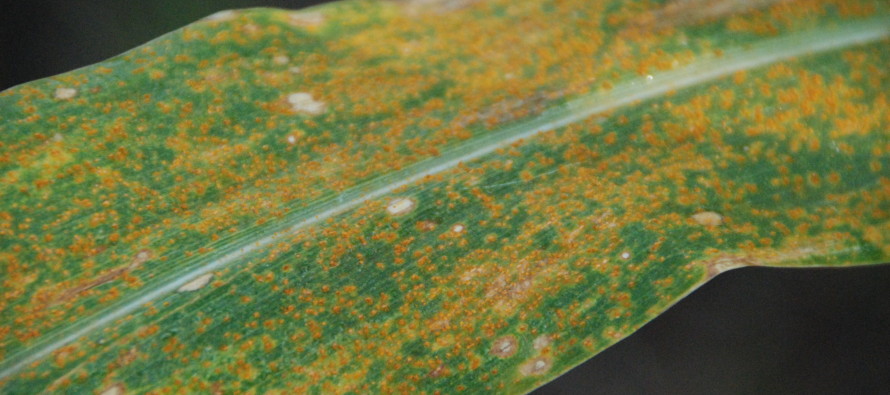Southern Corn Rust: Is a Late Fungicide Application Warranted?

Determining when to make a fungicide application to corn with foliar disease present is typically an issue of timing. Generally speaking, southern rust is the main disease of concern late in the season and one of the reasons the MSU Extension Service suggests early planting dates. At present, the distribution of southern rust in our corn production area is patchy. However, determining the latest growth stage timing that will benefit from a fungicide application (benefit = economically) is difficult. The majority of the efficacy trials that have been conducted in this particular area are with older fungicide chemistries and not with the newer strobilurin class of fungicides.
Over the past week I’ve heard folks suggest that “a corn plant will die in 4 days once infected with the southern rust fungus.†Not sure where that number is coming from, but I’ve seen corn infected with southern rust, and infected to what I would consider a high degree and the plants didn’t die even several weeks after an extreme level of infection. However, depending on the time of infection, southern rust can result in a more rapid dry down of leaf tissue if the disease is severe enough. During 2010, I had what I consider to have been a low to moderate level of southern rust infection in Stoneville. Fungicide trials were conducted at dent with several different product active ingredients in an attempt to determine which fungicides were efficacious against southern rust and which products prevented yield loss post-infection. In the particular field in question, southern rust was present at the ear leaf or above and I rated most of the plots at 20-30% incidence of disease meaning that the disease was present on 20-30% of the leaves within each plot and covered more than 20% of the leaf surface (from the ear leaf and above, once an ear is formed I stop scouting below the ear leaf). The one thing I learned that year regarding southern rust: even if you apply a fungicide the disease will likely appear to get worse post-application since some leaves are infected and pustules haven’t formed at the time of fungicide application. In addition, corn stalk integrity was maintained throughout the duration of the trial, up to and including harvest (which took place 34 days post-application). Since 2010 the number 1 question I’ve received regarding southern rust has to do with whether or not the leaves on the plant will die and cannibalization of the stalk will occur. Trial data from the 2010 fungicide trials was posted on the blog last year and can be accessed at:

Extreme level of southern rust infection from a field observed during 2008. Southern rust covered 70% of the leaf material in the field. Fungicides would not be effective in this particular situation due to the overwhelming amount of inoculum.
Keep in mind, this is a single year of data and the presence of southern rust was rated at a low to moderate level of disease incidence in the upper canopy in all of the plots that were sprayed. Results of fungicide applications made in other situations (e.g. a field with less disease, a field with more disease, a field containing a disease other than southern rust) may produce different results. In addition, as we have learned with other diseases in MS the product chosen may also produce different results in a given year and field situation.
So, short of scouting an entire corn field for the presence of southern rust, here are a few key points that should help address whether or not to apply a fungicide.
-Infection from southern rust will not degrade stalk integrity as long as the infection occurred after tasseling. Most of the corn in MS was likely infected by the fungus that causes southern rust post-tasseling unless the corn was planted extremely late.
-Infection in the lower canopy, below the ear leaf, will likely not lead to a reduction in overall yield.
-Finding low levels of the disease, and when I say low levels I mean enough to say you definitively have southern rust (a few pustules on a leaf and you can’t find any more in that field), does not necessarily trigger a fungicide application.
-All corn hybrids planted in MS should be considered to be susceptible to infection by the fungus that causes southern rust.
-Thresholds to determine the necessity of a fungicide application are not available for plant diseases since so many factors contribute to disease progress (e.g. time of infection, row spacing, irrigation method, prevailing temperature, rainfall, whether or not a fungicide has been applied, overall leaf tissue infected, location in the canopy).
-The majority of fungicide data from the past has suggested that a fungicide application with disease present in the field 2 weeks prior to black layer might not be economically beneficial. But, with that in mind grain prices at that time were likely much lower than today so the overall return-on-investment will differ if commodity prices are $6 to $7/bushel.
-Keep in mind that the specific yield potential of a particular field needs to be considered prior to making a fungicide application.





Thank you for this.